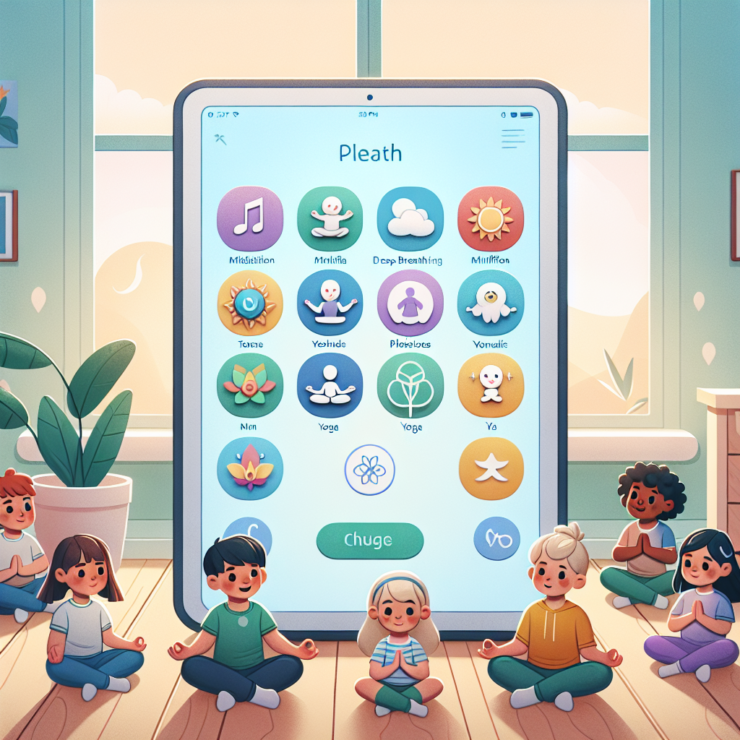Introduction to Mindfulness for Kids
In today’s fast-paced world, the mental well-being of children is as crucial as their physical health. Mindfulness, the practice of being fully present and engaged in the moment, has gained recognition as a tool for enhancing early development and fostering resilience.
The Importance of Mindfulness in Early Development
Mindfulness can play a pivotal role in the early stages of a child’s life. The brain of a child is remarkably plastic, meaning it has a high capacity for change and adaptation. Introducing mindfulness practices during this formative period can have a lasting impact on a child’s ability to manage emotions, cope with stress, and develop healthy habits of mind.
| Developmental Area | Benefits of Mindfulness |
|---|---|
| Emotional | Improved emotion regulation and resilience |
| Cognitive | Enhanced focus and attention |
| Social | Better conflict resolution and empathy |
| Physical | Lowered stress levels and increased relaxation |
Incorporating mindfulness into a child’s routine can lead to improved self-awareness and a greater capacity for compassion towards others. It can also serve as a foundation for building a robust mental framework, aiding children in navigating the complex social and academic pressures they face.
How Mindfulness Benefits Kids
Mindfulness equips children with valuable tools to face the challenges of growing up. By learning to pay attention to their thoughts and feelings without judgment, children can gain insights into their behaviors and reactions. This self-awareness can translate into better decision-making and problem-solving skills.
Mindfulness practices have been shown to offer numerous advantages for children, including:
- Stress Reduction: By recognizing and addressing stressors, mindfulness helps children alleviate anxiety and promotes a sense of calm.
- Enhanced Academic Performance: Improved concentration and focus through mindfulness can lead to better academic outcomes.
- Improved Social Skills: Mindfulness fosters empathy and communication skills, which are essential for positive social interactions.
- Better Sleep: Regular mindfulness exercises can contribute to healthier sleep patterns and more restful nights.
By embracing mindfulness, children can develop a toolkit of skills that will serve them throughout their lives. Mindfulness helps in cultivating a balanced and reflective approach to life’s ups and downs, paving the way for improved mental health and overall well-being.
Mindfulness Apps: A Modern Solution
What Are Mindfulness Apps?
Mindfulness apps are digital programs designed to promote mental wellness through mindfulness practices. These are interactive tools that can be accessed via smartphones, tablets, or computers. The primary goal is to facilitate the practice of mindfulness – a method of paying attention to the present moment with acceptance and without judgment. For children, these applications are tailored to be engaging and age-appropriate, incorporating elements such as games, animations, and stories to introduce the concepts of mindfulness in a relatable way.
How Mindfulness Apps Can Help Kids
Children today face a myriad of stressors that can impact their emotional well-being. Mindfulness apps for kids offer a convenient and accessible means for children to learn stress management and relaxation techniques. By incorporating daily mindfulness practices, kids can experience numerous benefits, which may include:
- Improved Focus: Regular mindfulness practices can enhance a child’s ability to concentrate both in academic settings and at home.
- Emotional Regulation: Learning mindfulness can help children understand and manage their emotions more effectively.
- Reduced Stress: Engaging in mindfulness exercises can lower stress levels, leading to a more balanced state of mind.
- Better Sleep: Mindfulness routines before bedtime can contribute to improved sleep quality and duration.
- Enhanced Resilience: Mindfulness can foster resilience, giving children tools to cope with challenges more adaptively.
| Benefit | Description |
|---|---|
| Improved Focus | Enhances concentration and attentiveness |
| Emotional Regulation | Aids in understanding and managing feelings |
| Reduced Stress | Lowers anxiety and promotes calmness |
| Better Sleep | Contributes to more restful and deeper sleep |
| Enhanced Resilience | Builds capacity to handle life’s challenges |
By integrating mindfulness apps into their daily routines, children can develop lifelong skills that bolster their ability to navigate life with a sense of calm and purpose. Parents and caregivers play a pivotal role in guiding children on how to use these digital tools effectively to reap the full benefits of mindfulness practices.
Features of Mindfulness Apps for Kids
Mindfulness apps designed for children incorporate various features that engage young minds while teaching them valuable skills for managing emotions and stress. These features are tailored to be age-appropriate and cater to the unique needs of kids as they learn the principles of mindfulness.
Interactive Activities
One of the core elements of mindfulness apps for kids is interactive activities. These activities are crafted to be fun and engaging, often using game-like interfaces to maintain a child’s attention. They may involve tasks such as completing puzzles that focus on mindfulness themes or interactive challenges that encourage children to practice mindfulness in their daily lives.
Interactive activities not only keep children entertained but also help them to learn mindfulness concepts in an experiential way. By actively participating in these activities, kids can better understand and apply mindfulness techniques to their own lives.
Guided Meditations and Stories
Guided meditations and stories are another pivotal feature of mindfulness apps for kids. Narrated by soothing voices, these guided sessions are designed to help children relax and find a sense of peace. Meditations may focus on different themes, such as kindness, gratitude, or self-compassion, and are often of varying lengths to suit different attention spans.
Stories, on the other hand, often incorporate mindfulness lessons within engaging narratives. Through storytelling, children can learn about managing emotions, developing empathy, and other mindfulness principles in a way that resonates with them.
Breathing Exercises and Relaxation Techniques
Breathing exercises and relaxation techniques are fundamental aspects of mindfulness that are adapted for kids within these apps. These features teach children how to use their breath as a tool to calm their minds and bodies. Simple instructions guide them through various breathing patterns and techniques, which they can use to manage stress or anxiety.
Relaxation techniques may also include progressive muscle relaxation or visualizations that help children to unwind and find a sense of tranquility. By practicing these techniques regularly, children can develop a toolkit of strategies for coping with challenging situations.
Selecting the Right Mindfulness App for Your Child
Selecting the appropriate mindfulness application for a child is a task that requires careful consideration of several factors. These applications can be powerful tools for promoting emotional well-being, but they must be suitable for the child’s age, engaging, and safe to use.
Age Appropriateness
Mindfulness apps for kids are designed to cater to various age groups, with content tailored to the developmental stage of the child. It is vital to choose an app that aligns with your child’s comprehension and interest levels to ensure that they can fully benefit from the mindfulness practices offered.
| Age Group | Focus Area |
|---|---|
| 3-5 years | Simple breathing exercises, short stories |
| 6-8 years | Basic meditation practices, interactive mindfulness games |
| 9-12 years | Advanced guided meditations, emotional self-awareness activities |
Selecting an app that is too advanced may lead to frustration, while one that is too simplistic might not hold their interest. It’s essential to find the sweet spot that both challenges and engages them.
Engaging Content for Kids
The content within mindfulness apps for kids should be captivating and enjoyable to encourage regular use. Look for apps that incorporate a variety of activities, such as games, stories, and animated characters, which can make mindfulness practice more relatable and fun for children.
Engagement can be fostered through:
- Interactive Activities: Activities that require active participation can help children learn by doing.
- Storytelling: Narratives that incorporate mindfulness lessons can be both educational and entertaining.
- Gamification: Incorporating game-like elements can motivate children to use the app consistently.
These features not only make the app more appealing but also help in retaining the child’s attention and promoting consistent practice.
Parental Controls and Safety
Safety is paramount when it comes to digital tools for children. Mindfulness apps should have robust parental controls that allow parents to monitor and control the child’s usage. This includes the ability to set time limits, track progress, and restrict access to certain content.
| Feature | Purpose |
|---|---|
| Time Management | Set limits on app usage to prevent overuse |
| Progress Tracking | Monitor the child’s engagement and improvements |
| Content Restrictions | Ensure the child only accesses age-appropriate material |
Additionally, the app should comply with privacy laws and regulations, ensuring that personal data, if collected, is protected and not misused. Parents should verify the app’s safety credentials before introducing it to their children.
Integrating Mindfulness Apps into Daily Routines
Incorporating mindfulness applications into the daily lives of children can be a transformative tool for fostering relaxation and mental clarity. For parents and caregivers, the challenge often lies in seamlessly blending these digital resources into regular routines.
Creating a Calm Environment at Home
Establishing a tranquil atmosphere at home is crucial for the effectiveness of mindfulness practices. It sets the stage for a child to engage fully with mindfulness apps and reap the full benefits. Here are steps to create a serene space:
- Designate a quiet area where your child can use the mindfulness app without distractions.
- Ensure the space is comfortable and inviting, with cushions, soft lighting, or plants.
- Encourage other family members to respect the calm environment when it’s in use.
These simple adjustments to the home setting can significantly enhance a child’s mindfulness experience.
Encouraging Regular Use for Maximum Benefit
Consistency is key when it comes to mindfulness practice. Encouraging children to use mindfulness apps regularly can help them develop a routine that supports their mental well-being. Consider these tips:
- Set a specific time each day for mindfulness practice, such as before bedtime or after school.
- Pair the mindfulness app session with another daily activity to form a habit.
- Use reminders or alarms to prompt your child when it’s time to engage with the app.
| Daily Activity | Mindfulness Session Time |
|---|---|
| Afternoon Snack | 10 minutes post-snack |
| Homework Completion | 15 minutes post-homework |
| Pre-Bedtime Routine | 20 minutes before lights out |
By integrating mindfulness sessions into the day-to-day activities, children are more likely to stick to the practice and internalize its benefits.
Tracking Progress and Observing Changes
Monitoring a child’s progress with mindfulness apps can provide valuable insights into their development and well-being. Here’s how parents can track and observe:
- Keep a simple log of usage, noting the frequency and duration of app use.
- Observe any changes in the child’s behavior or emotional state over time.
- Engage in discussions with your child about their experience and feelings.
| Week | Frequency of Use | Duration | Observed Changes |
|---|---|---|---|
| 1 | 5 days | 10 mins/day | More relaxed at bedtime |
| 2 | 6 days | 15 mins/day | Better focus on tasks |
By keeping track of these details, parents can tailor the mindfulness experience to better suit their child’s needs and celebrate the positive changes that arise from consistent practice.
Supporting Mindfulness Beyond the Screen
While mindfulness apps for kids offer a convenient and engaging way to teach mindfulness, it is equally important to incorporate these practices off-screen. Supporting mindfulness through daily life can enhance the benefits and foster a well-rounded approach to emotional regulation and stress management.
Mindful Parenting Techniques
Mindful parenting is characterized by parents being fully present with their children, providing them with undivided attention and responding to their needs with kindness and patience. This involves active listening, empathy, and non-judgmental acceptance. By embodying these practices, parents can create a more peaceful home environment and teach by example.
Here are some techniques parents can use:
- Active Listening: Give full attention when the child is speaking, without interrupting or offering unsolicited advice.
- Empathy: Acknowledge the child’s feelings and show understanding.
- Patience: Respond to behaviors and mistakes with a calm demeanor.
- Presence: Engage in activities with the child without distractions like phones or other devices.
Activities to Complement Digital Mindfulness Practices
To complement the digital mindfulness practices learned through apps, various activities can be integrated into a child’s routine:
- Mindful Walking: Encourage children to notice the sensations of their feet touching the ground and the sounds and sights around them.
- Nature Connection: Spend time outdoors, observing the natural environment with curiosity.
- Art: Use drawing, painting, or coloring as a way to focus the mind and express emotions.
- Journaling: Older children can benefit from writing down thoughts and feelings to reflect on their experiences.
These activities can be logged in a simple table to track which ones the child responds to most positively:
| Activity | Response | Frequency |
|---|---|---|
| Mindful Walking | Positive | Daily |
| Nature Connection | Very Positive | Weekly |
| Art | Positive | As Desired |
| Journaling | Mixed | Weekly |
Fostering a Mindful Lifestyle for the Whole Family
A mindful lifestyle is beneficial for all family members, not just children. To foster this, families can:
- Establish daily routines that include mindfulness practices.
- Share experiences and discuss what they’ve learned from mindfulness apps and activities.
- Set aside tech-free time to connect with one another and engage in mindful communication.
By integrating these practices into daily life, families can experience the full spectrum of mindfulness benefits, creating a more harmonious and supportive environment for everyone’s growth and well-being.











